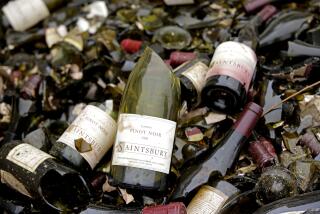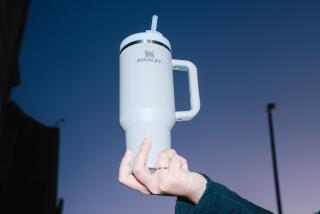COLLECTIBLES : Bottled-Up Value Is a Glass Act
- Share via
Bottle collecting is one of the oldest, most popular and least expensive fields of antiques, in which one man’s trash is another man’s treasure--but in rare instances those treasures can be worth thousands of dollars.
Glass bottles in nearly every imaginable form and color have been produced in this country, and just about every old house and antiques mall contains old bottles--patent-medicine bottles, or barber, beer or bitters containers.
Glass bottles reflect the industrial development of the United States. The colonists’ demand for glass windows and containers, combined with a ready supply of wood to fuel glass-house furnaces, encouraged the establishment of an American glass-blowing industry as early as the 18th Century.
American glass houses came to rival their European counterparts. Technological developments in the 19th Century led to more uniform, colorful and decorative bottles with smooth lips and, later, molded screw threads.
Veteran bottle collectors have learned that gems can turn up anywhere, from the basement of an old house to the rafters of an attic or barn. Many collectors search inactive dumps and house foundations, watch as city workers excavate for new utility lines or even perform archeological digs on the sites of turn-of-the-century outhouses.
Among the bottle types that collectors seek are:
* Barber bottles. During the latter half of the 19th Century, barbers mixed and bottled their own hair tonics and colognes. The Pure Food and Drug Act in 1906 restricted many of the ingredients in these homemade formulas, so the number of barber bottles declined after that. They are highly collectible, in the $200-$300 price range.
* Beer bottles. In general, beer bottles are more common than barber bottles, although rarities do exist. A common brand such as Utica Club might bring only a few dollars, but a rare cobalt-blue SH Broughton Root Porter bottle could fetch nearly $500.
* Bitters bottles. Bitters collectors place a premium on unusual colors. For instance, an amber example of Kellys Old Cabin Bitters might bring $700-$900 at auction, but a rare dark olive-green version could easily climb to $3,000-$4,500.
* Candy containers. The most desirable are those in detailed, unusual shapes, such as early 20th-Century airplanes, firearms, animals and historic buildings. With many now priced under $100, candy containers may be one of the best buys in the field.
* Flasks. The best-known collectible bottles are figured flasks. Figurals have featured American presidents, military leaders and politicians, as well as patriotic themes and Masonic lodge insignias. Color is a critical factor in determining flask value. A transparent George Washington flask might cost $50-$80, while a similar flask in sapphire blue is worth $4,000.
* Ink bottles. The number and variety of forms have made this category one of the most popular. The earliest American ink bottles were relatively small and plain. By the mid-1800s, competition among ink manufacturers led to fancier, more unusual shapes. Ink bottles can be found in the shape of cottages, eagles, lions, locomotives, even snails, but two of the most common are the teakettle and umbrella designs.
* Medicine bottles. Patent medicines of the 19th Century promised to cure everything from malaria to hair loss, and their fancy glass bottles have attracted a great deal of attention. Because so many medicine bottles are inexpensive yet colorful, they are a popular item with beginning collectors.


